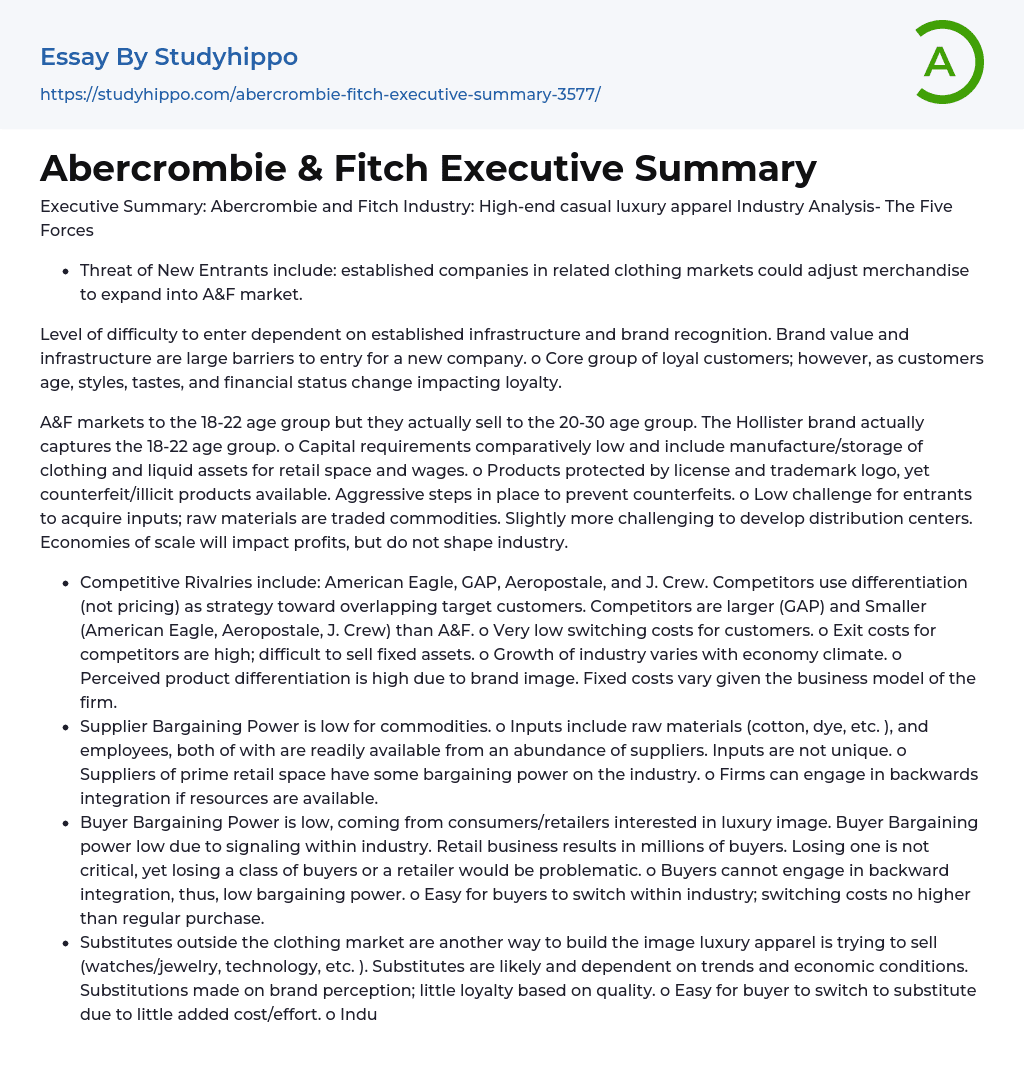Executive Summary: Abercrombie and Fitch Industry: High-end casual luxury apparel Industry Analysis- The Five Forces
- Threat of New Entrants include: established companies in related clothing markets could adjust merchandise to expand into A&F market.
Level of difficulty to enter dependent on established infrastructure and brand recognition. Brand value and infrastructure are large barriers to entry for a new company. o Core group of loyal customers; however, as customers age, styles, tastes, and financial status change impacting loyalty.
A&F markets to the 18-22 age group but they actually sell to the 20-30 age group. The Hollister brand actually captures the 18-22 age group. o Capital requirements comparatively low and include manufacture/storage of clothing and liquid assets for retail space and wages. o Products protected by license and trademark logo, yet counterfeit/illicit products available. Aggressive steps in
...place to prevent counterfeits. o Low challenge for entrants to acquire inputs; raw materials are traded commodities. Slightly more challenging to develop distribution centers. Economies of scale will impact profits, but do not shape industry.
- Competitive Rivalries include: American Eagle, GAP, Aeropostale, and J. Crew. Competitors use differentiation (not pricing) as strategy toward overlapping target customers. Competitors are larger (GAP) and Smaller (American Eagle, Aeropostale, J. Crew) than A&F. o Very low switching costs for customers. o Exit costs for competitors are high; difficult to sell fixed assets. o Growth of industry varies with economy climate. o Perceived product differentiation is high due to brand image. Fixed costs vary given the business model of the firm.
- Supplier Bargaining Power is low for commodities. o Inputs include raw materials (cotton, dye, etc. ), and employees, both of with are readily available from an
abundance of suppliers. Inputs are not unique. o Suppliers of prime retail space have some bargaining power on the industry. o Firms can engage in backwards integration if resources are available.
luxury brand for products. o Is extremely valuable because attracts the 14-30 age group and promotes brand exclusivity. Brand image is not easily imitable without companies changing business model; for target group it is difficult to substitute because of demand. o Rare, controversial, and easily identifiable branding has caused increased publicity for A&F resulting in more demand by teenagers.
Strategic Positioning
- Strengths- Backwards Integration, brand recognition, customer loyalty.
- Weaknesses- Damaging effects to brand of lowering price, narrow customer base, overexpansion. • Opportunities- Expansion of product line.
- Threats- Economic downturn, substitute products. A&F’s success is based on focused differentiation. A&F could widen their available product line to increase revenue and reduce the threat of substitutes by offering comparable products within the A&F brand. Possible additions include leather goods, travel accessories, and casual jewelry. A&F has already tested expansions in product lines with colognes, sandals, etc.
- A potential caveat is overly aggressive expansion into foreign markets. A&F needs to retain more cash instead of focusing on expansion, because foreign markets will not save a stagnating domestic company. A&F could broaden gaps between brands. Hollister has engaged in price differentiation; Hollister brand is considerably lower in price in comparison to A&F and has a marketing strategy focused on the California beach mentality. This captures the younger demographic that A&F quotes as their target market. While premiums could fall, their sales and revenue would likely rise.
- Product and service differentiation would be prudent in the circumstance of a stagnating business that has already expanded its firm in price differentiation with Hollister.
- Classical Mechanics essays
- Rail Transport essays
- Tata Motors essays
- Vehicle Brands essays
- trucks essays
- Auto Racing essays
- Harley-Davidson essays
- Suzuki essays
- Lexus essays
- Mercedes-Benz essays
- Wal-Mart essays
- Discover essays
- Renault essays
- Truck essays
- chrysler essays
- The city essays
- Racing essays
- Automotive essays
- Automotive Industry essays
- Commerce essays
- Construction essays
- E Commerce essays
- Grocery stores essays
- Paper Industry essays
- Pharmaceutical industry essays
- Pharmacy essays
- Polymers essays
- Real Estate essays
- Textile Industry essays
- Advertisement essays
- Advertising essays
- Anheuser-busch essays
- Audience Theory essays
- Brand essays
- Brands essays
- Competitor Analysis essays
- Consumer essays
- Detergent essays
- Marketing Management essays
- Marketing Mix essays
- Marketing Plan essays
- Marketing Research essays
- Marketing Strategy essays
- New Product Development essays
- Point Of Sale essays
- Price essays
- Procurement essays
- Product essays
- Product Differentiation essays
- Product Placement essays




